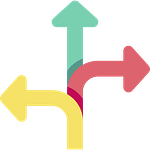In the realm of software delivery methodologies, two prominent approaches stand out: Agile and Waterfall. Each method has its own set of strengths and weaknesses, and understanding the differences between them is crucial for successful project delivery. However, in an ever-evolving landscape, there’s a growing recognition of the need for a more combined approach that harnesses the best of both worlds.

Agile Methodology
Agile is a flexible and iterative approach to software development and delivery. It emphasises collaboration, customer feedback, and the ability to adapt to change throughout the delivery process. In Agile, projects are divided into small increments called sprints, with each sprint delivering a functional piece of the software. This iterative process allows for early and continuous delivery of valuable software, fostering better communication and faster response to changes in requirements
Waterfall Methodology
Contrary to Agile, the Waterfall model follows a linear and sequential approach to development. It consists of distinct phases, such as requirements gathering, design, implementation, testing, and deployment, with each phase dependent on the completion of the previous one. Waterfall is known for its structured and predictable nature, making it suitable for projects with well-defined requirements and stable environments. However, its rigid structure often lacks the flexibility to accommodate changes and feedback late in the development cycle.
The Need for a Combined Approach
While both Agile and Waterfall have their merits, they also have their limitations. Agile excels in adaptability and customer collaboration, but it can sometimes lack predictability and structure. On the other hand, Waterfall provides structure and clarity but struggles with accommodating changes and feedback.
Recognising these strengths and weaknesses, many organisations are adopting a more combined approach known as “Agile-Waterfall” or “Hybrid Agile.” This approach combines the flexibility of Agile with the structure of Waterfall, allowing teams to leverage the benefits of both methodologies. Read our related article ‘What is SAFe?’.
- Flexibility and Structure: By blending Agile and Waterfall principles, teams can maintain flexibility while also adhering to a structured framework.
- Adaptability: Teams can adjust their approach based on the project’s requirements, complexity, and stakeholder preferences.
- Risk Management: Combining Agile’s iterative nature with Waterfall’s emphasis on planning helps mitigate risks and uncertainties.
- Efficiency: Teams can capitalise on Agile’s quick feedback loops and Waterfall’s clear milestones to improve efficiency and productivity.
Conclusion
In today’s dynamic and competitive environment, the debate between Agile and Waterfall is no longer about choosing one over the other. Instead, it’s about finding the right balance and adopting a combined approach that best suits the project’s needs. By integrating Agile and Waterfall principles, organisations can maximise their chances of success and deliver high-quality software that meets both customer expectations and business objectives. Read our related article ‘What is SAFe?’.